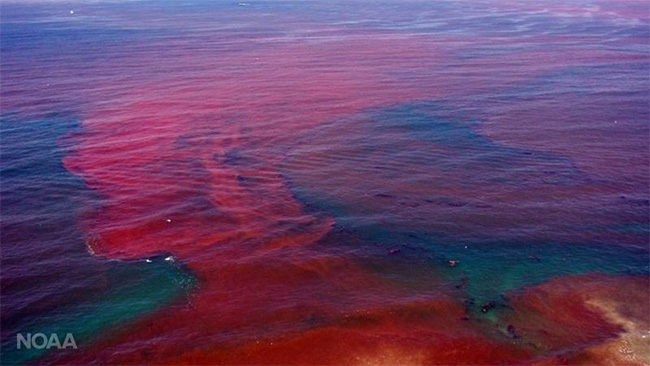Is the Red Sea really as red as the name suggests?
Long and narrow, the Red Sea lies between northeastern Africa and Asia. It extends about 1,930km from the Gulf of Suez in the north to the Gulf of Aden in the south, finally connecting with the Indian Ocean. The maximum width of the Red Sea is 305km and its maximum depth is 3,040 meters, with an area of about 450,000 square kilometers.


Location of the red sea on the map.
Satellite images taken from space show the Red Sea as a stretch of blue running from north to south along the northeastern edge of Africa.
The dark green here contrasts with the gray-brown color of the surrounding landscape. Water color is not at all red as the name of the sea.
So why does this sea area have such a famous nickname?
"I don't think anyone can give a definite answer, there are a number of theories regarding what," said Karine Kleinhaus, an associate professor of marine and atmospheric sciences at Stony Brook University in New York, USA. name of the Red Sea".
According to NASA's Earth observatory, the origin of the name Red Sea is related to a type of algae Trichodesmium erythraeum.
T. erythraeum grows very strongly, appearing in most of the tropical and subtropical oceans in the world, especially the Red Sea area. Here, the algae bloom periodically, the population increases rapidly, when the algae die, the red-brown water spreads over the sea.
However, Karine Kleinhaus shares that the name Red Sea could also be named after the red mountains located near the coastline.
The Red Sea is not only famous for its strange, curious name, it is an interesting place of biodiversity with many endemic species of animals found only in this sea.
The Red Sea is home to one of the longest continuous coral reefs in the world. It spans 4,000km. According to Kleinhaus, the unique features of the reef make the Red Sea one of the only marine areas in the world less affected by climate change.
Karine Kleinhaus said: "The corals that grew there at the end of the last ice age were the ones that could tolerate very high temperatures and salinities. So the corals here are doing well under rising temperatures, It is estimated to be one of the last surviving reefs of this century."
- Why did tyrannosaurs have two very small forelimbs?
- Memory of Fido dog
- 7 tips to speed up website
- The bigger the horn, the smaller the quarter's
- Conflict about the origin of birds
- Iceberg, not only harmful?
- Earthquake warning system: only a few minutes
- Neanderthals used to ... debate
- A planet may be changing, coming to life right next to Earth
- Is happiness inherited or not?
- Submarine-type fish
- Restore computer when infected with Trojan or Virus
 Surprised: Fish that live in the dark ocean still see colors
Surprised: Fish that live in the dark ocean still see colors Japan suddenly caught the creature that caused the earthquake in the legend
Japan suddenly caught the creature that caused the earthquake in the legend A series of gray whale carcasses washed ashore on California's coast
A series of gray whale carcasses washed ashore on California's coast Compare the size of shark species in the world
Compare the size of shark species in the world